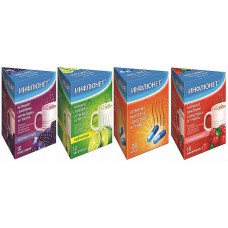Expiration date: 01/2026
Composition and form of issue:
Capsules. 1 capsule contains:
paracetamol 175 mg
ascorbic acid 150 mg
succinic acid 60 mg
of rutin trihydrate (calculated as rutin) 10 mg
phenylephrine hydrochloride 2, 5 mg
excipients: giprolose-4, 5 mg silicon colloidal dioxide-2, 5 mg lactose monohydrate-21, 3 mg magnesium stearate-4, 2 mg
hard gelatin capsule contains: gelatin, Indigo Carmine (E132), colorant brilliant blue (E133), titanium dioxide (E171)
in a contour cell package 10 PCs. in a pack of cardboard 1, 2 or 4 packages.
Powder for oral solution (cranberry, lime, forest berries, raspberry, mint). 1 sachet contains:
paracetamol 350 mg
ascorbic acid 300 mg
succinic acid 120 mg
of rutin trihydrate (calculated as rutin) 20 mg
phenylephrine hydrochloride 5 mg
excipients: flavor of cranberry or lime flavoring, or flavoring of wild berries, raspberry, or flavor, or mint flavor — 60 mg aspartame 30 mg of hyprolose 30 mg of colloidal silicon dioxide 10 mg lactose monohydrate — 4075 mg
in bags of heat-welded film material combined by 5 g in a carton pack of 2, 3, 6, 10, 16 or 50 PCs.
Description of dosage form:
Capsules:, body blue, cover blue.
The contents of the capsules are a mixture of powder and / or yellow granules with a greenish tint of color. Allowed the presence of lumps, which when pressed with a glass rod easily converted into powder.
Powder for oral solution. The contents of the bag is a mixture of powder and / or granules from light yellow to yellow with a greenish tint of color with the smell of cranberries or lime, or berries, or raspberries, or mint.
The solution (after dissolving the contents of one sachet in 200 ml of water) — muddy with a yellowish-greenish tint with a characteristic smell (cranberries, lime, berries, raspberries, mint). The presence of undissolved yellow particles is allowed.
Description of pharmacological action:
Combined preparation.
Paracetamol has antipyretic, analgesic effect.
Ascorbic acid is involved in the regulation of carbohydrate metabolism, oxidation-reduction processes, the synthesis of steroid hormones, tissue regeneration, activates immune reactions, reduces capillary permeability, enhances detoxification function of the liver, regulates blood coagulation.
Succinic acid enhances biochemical and physiological recovery processes. It has hepatoprotective, immunomodulatory and antioxidant effects. Activates energy processes in mitochondria, normalizes cell membrane permeability, is an intermediate of Krebs cycle. In combination with drugs increases their positive effect and reduces the manifestations of toxic effects.
Rutozid reduces capillary permeability, relieves swelling and inflammation, strengthens the vascular wall, inhibits aggregation and increases the degree of deformation of red blood cells.
Phenylephrine stimulates postsynaptic alpha-adrenoreceptors, reduces swelling and hyperemia of the nasal mucosa, restores free breathing, lowers pressure in the paranasal cavities and middle ear.
Indications:
Symptomatic treatment of colds and flu, accompanied by fever, headache, chills, nasal congestion, sore throat and sinuses.
Contraindications:
- hypersensitivity to one or more components of the drug
- severe liver and kidney damage (acute hepatitis, acute pyelonephritis, acute glomerulonephritis or exacerbation of chronic diseases of these organs)
- gastric and duodenal ulcer
- glaucoma
- tendency to thrombosis
- diabetes
- hypertension, bradycardia, ventricular tachycardia, heart failure, conduction disorders, ventricular fibrillation, severe atherosclerosis, severe aortic stenosis, acute myocardial infarction
- pheochromocytoma, hyperthyroidism, prostatic hyperplasia
- simultaneous administration of tricyclic antidepressants, beta-blockers, MAO inhibitors (including within 14 days after their withdrawal), other paracetamol-containing drugs
- lactose intolerance, lactase deficiency, glucose-galactose malabsorption syndrome
- pregnancy
- lactation
- children under 18 years of age.
With caution-benign hyperbilirubinemia, congenital deficiency of glucose-6-phosphate dehydrogenase.
Side effect:
From the blood and CCC: agranulocytosis, thrombocytopenia, thrombocytosis, hyperprothrombinemia, erythropenia, neutrophilic leukocytosis, anemia increase blood PRESSURE, bradycardia, arrhythmia, angina.
From the nervous system and sensory organs: headache, excitement, irritability, anxiety, weakness, dizziness, respiratory depression, tremor.
From the digestive tract: nausea, vomiting, diarrhea.
From the metabolism: metabolic disorders, inhibition of glycogen synthesis, excessive formation of corticosteroids, sodium and water retention, hypokalemia.
From the urogenital system: increase or decrease in diuresis, damage to the glomerular apparatus of the kidneys, the formation of oxalate urinary stones.
Allergic reactions: skin rashes, hyperemia.
Drug interaction:
If you need a joint reception with other drugs, you should consult your doctor. Stimulators of microsomal oxidation in the liver (phenytoin, ethanol, barbiturates, rifampicin, phenylbutazone, tricyclic antidepressants) increase the production of hydroxylated active metabolites of paracetamol, which makes it possible to develop severe intoxication with small overdoses.
Paracetamol enhances the effects of MAO inhibitors, sedative drugs, ethanol.
Antidepressants, antiparkinsonian, antipsychotic drugs, phenothiazine derivatives increase the risk of urinary retention, dryness in the mouth, constipation.
Glucocorticoid agents increase the risk of glaucoma. Phenylephrine reduces the hypotensive effect of guanethidine. Guanetidin enhances alpha given effect, and tricyclic antidepressants the sympathomimetic effect fenilafrina.
Dosage and administration:
Capsules. Inside, after eating, drinking plenty of water. Adults-2 caps. after 4-6 hours, but not more than 4 times a day, for 3-5 days.
If within 3-5 days after the start of taking the drug does not improve health, you should stop taking the drug and consult a doctor.
Powder for oral solution. Inside. Dissolve the contents of 1 sachet in 1 Cup of boiled hot water. Use hot. Before use, stir the solution. Adults - one bag after 4-6 hours, but no more than 4 times a day, for 3-5 days.
If within 3-5 days after the start of taking the drug does not improve health, you should stop taking the drug and consult a doctor.
Overdose:
Symptoms: pale skin, anorexia, nausea, vomiting and abdominal pain, increased activity of hepatic transaminases, increased PV, hepatonecrosis, arrhythmia, ventricular tachycardia, increased blood PRESSURE.
Treatment: gastric lavage, appointment of adsorbents, symptomatic therapy. The antidote for paracetamol is acetylcysteine.
It is necessary to consult a doctor.
Special instruction:
Duration of application-no more than 5 days.
Distorts the results of laboratory tests that evaluate the concentration of glucose and uric acid in plasma.
Persons who are prone to use ethanol should consult a doctor before treatment, since paracetamol can have a damaging effect on the liver.






